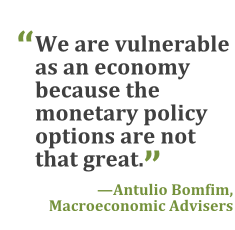The Federal Reserve Board's army of economists are the ultimateumbrella people: They prepare for rain on sunny days.
|Even though no Federal Open Market Committee (FOMC)member has forecast a recession in the next three years, a shakyglobal environment has clouded the U.S. economic outlook. With thecentral bank's main policy rate stuck at zero since December 2008,that means Fed staff is probably already mulling other ways tostimulate growth.
|Here are three tools at Fed policy makers' disposal—along withtheir benefits and drawbacks.
|1. More forward guidance.
|What: The Fed could offer more hints to investors about when itwill raise rates and at what speed. If those communications suggestpolicy makers will raise rates more slowly than investors hadpreviously expected, borrowing costs could decline, which may spurborrowing and spending.
| Pro:This is the easiest option because it costs nothing, and it wasalso the last tool the Fed used to squeeze extra stimulus out ofits current zero-rate policy.
Pro:This is the easiest option because it costs nothing, and it wasalso the last tool the Fed used to squeeze extra stimulus out ofits current zero-rate policy.
Con: The punch from this stimulus could be limited becauseshort-term yields, the place where the Fed can most credibly guideinvestors on rates, are already low. The U.S. Treasury's 3-yearnote yields just 0.90 percent.
|“The market is not going to need any forward guidance if thereis a recession and 2-, 3-, and 4-year rates are down to zero,” saysRoberto Perli, a partner at Cornerstone Macro LLC in Washington andformer member of the Fed's Division of Monetary Affairs.
|2. More QE.
|What: The Fed could buy more bonds in a policy known asquantitative easing (QE).
|Pro: It is very effective in a financial crisis, according toresearchers such as Joseph Gagnon at the Peterson Institute forInternational Economics in Washington. He and his co-authors in areport found ”economically meaningful and long-lastingreductions in longer-term interest rates” in the last rounds ofquantitative easing.
|Cons: In a recession where financial stress isn't the mainfeature, bond purchases may be less effective. Evenlonger-term bond yields are already low, so there's not much to begained. The U.S. 10-year note yields about 2 percent today,compared with 3.11 percent when the central bank began purchasingbonds outright in 2008. There are also the potential complicationsof exiting a balance sheet that swelled to $4.5 trillion fromprevious rounds of QE. The political blowback in aRepublican-controlled Congress, where QE was never popular, couldcause more headaches for the central bank.
|3. Negative interest rates.
|What: The Fed could lower its main policy rate below zero,something it has never done. The target rate is currently atbetween zero and 0.25 percent.
|Pros: Countries like Sweden have started to experiment withthis, and there doesn't seem to be a lot of financialinstability associated with it. It could weaken the dollar againstother major currencies, which would help Americanexporters. Faced with having to pay a bank to hold theirmoney, depositors may choose to take on more risk by shiftingfunds into assets with longer maturities, pushing down interestrates further along the yield curve. They could also end upspending more money.
|The idea has support from at least two regional Fed bankpresidents: Naryana Kocherlakota of Minneapolis and John Williamsof San Francisco.
|Cons: The U.S. financial system is more diverse than Europe's.The American banking system is populated with thousands ofcommunity banks that rely almost solely on depositors for loanablefunds.
|A migration away from small banks into zero-yieldingproducts—cash, debit cards, or money-market funds that might find away to keep returns less negative than a bank deposit—could disruptcredit creation. That would defeat the purpose of the policy.
|“Individuals expect a return for parking their money in a localbank,” said Paul Merski, chief economist for the IndependentCommunity Bankers of America in Washington. “The lower that return,the less lending” if deposits migrate.
|The goal of investment in short-term assets, says Joseph Abate,a money market strategist at Barclays in New York, becomes “losingless money,” and the distortions that creates may not be worth thetrouble.
|“You are really entering a point where fiscal policy is calledfor,” Abate says. “You have reached the end-point of sensiblemonetary policy.”
|The Bottom Line
|The Fed doesn't have very many good options, and that is why Fedofficials such as Lael Brainard are arguing that the downside risksof raising interest rates too soon are larger than the risks ofbeing too late and triggering faster inflation in the future. TheFed knows how to fight inflation.
|“We are vulnerable as an economy because the monetary policyoptions are not that great,” said Antulio Bomfim, senior managingdirector at Macroeconomic Advisers LLC.
|Copyright 2018 Bloomberg. All rightsreserved. This material may not be published, broadcast, rewritten,or redistributed.
Complete your profile to continue reading and get FREE access to Treasury & Risk, part of your ALM digital membership.
Your access to unlimited Treasury & Risk content isn’t changing.
Once you are an ALM digital member, you’ll receive:
- Critical Treasury & Risk information including in-depth analysis of treasury and finance best practices, case studies with corporate innovators, informative newsletters, educational webcasts and videos, and resources from industry leaders.
- Exclusive discounts on ALM and Treasury & Risk events.
- Access to other award-winning ALM websites including PropertyCasualty360.com and Law.com.
*May exclude premium content
Already have an account? Sign In
© 2024 ALM Global, LLC, All Rights Reserved. Request academic re-use from www.copyright.com. All other uses, submit a request to [email protected]. For more information visit Asset & Logo Licensing.







